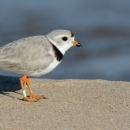These guidelines are a tool for beach managers and property owners seeking to avoid potential violations of Section 9 of the Endangered Species Act and its implementing regulations. Violations can occur as the result of recreational activities on beaches used by breeding piping plovers. These guidelines are our best professional advice regarding management options that will prevent direct mortality, harm or harassment of plovers and their eggs.
Publication date
Type of document
Guidance
Program
Species
FWS Focus
Ecosystem
FWS and DOI Region(s)


